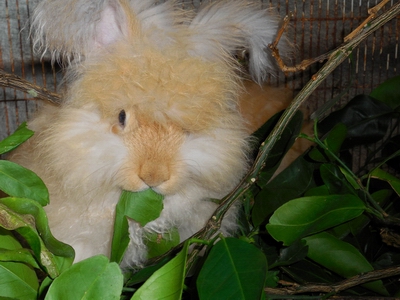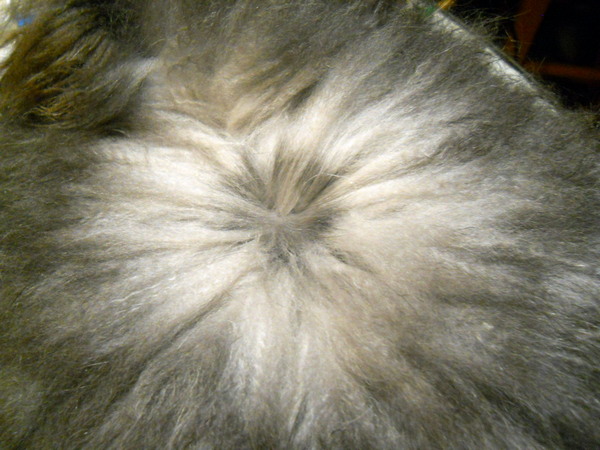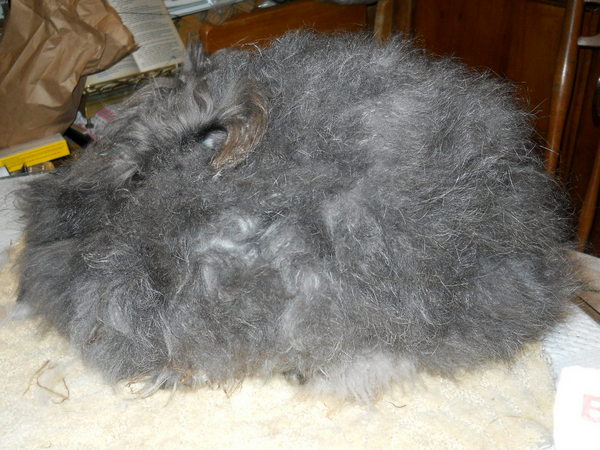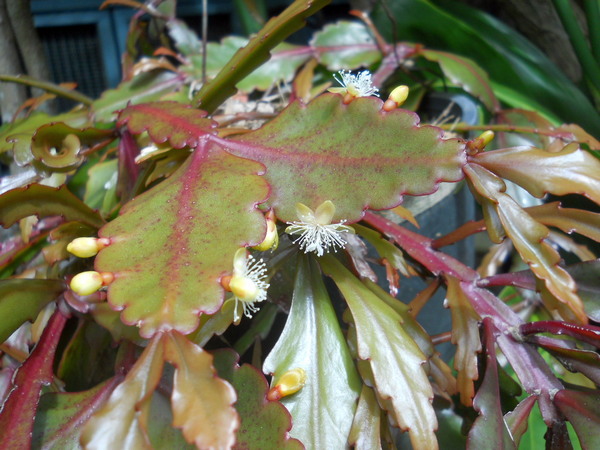

The penicillin treatment is finished, at least, we hope so. All twenty Hillside bunnies plus one visiting bunny have been getting weekly penicillin shots for the past five weeks. This has been to clear up suspected vent disease which is what we now suspect has been creating the infertility problem we've been dealing with for the past few years. We could possibly give the herd one or two more weeks of treatment if we wanted, but it should be cleared up now. According to assorted websites about the cure for this disease, there's quite a bit of leeway in the amount of penicillin given, the type of penicillin given and the amount and duration of treatment as well. Most of these websites were 'valid' sources such as veterinary websites, medical websites or university agricultural websites. But the data was all over the map. We followed a fairly conservative route, but also want to make sure it's gone.
There were two different types of penicillin they kept mentioning, 'long duration' and 'short duration'. Although, even 'long' duration didn't seem to last all that long. Then the amount per kilogram of body weight was from 42,000 UI to 84,000 UI or so. That's rather a broad range, IMHO. Anywhere from one shot per day for a week (usually that was for the 'short duration' penicillin, but not always) to weekly shots for four to seven weeks. The bunnies here - as of yesterday - have now gotten 42,000 UI of penicillin per kilo of bunny once a week for five weeks. At least so far. I think their treatment is finished, although there's enough Durapen left we could give them another round of shots for a couple more weeks if we wanted to extend the treatment to seven weeks. So hopefully, they no longer have vent disease and we will start seeing baby bunnies again.
I'd been wondering how the bunnies could have been exposed to vent disease, it's generally a sexually transmitted disease, although babies and mothers can swap it back and forth, too. I'd forgotten that several years ago, a baby bunny who's mother had died was fostered here for a bit. I'd originally thought the mom bun had been done in by some sort of physical thing such as the neighbor's dog or some such since that's usually the prevaling reason for the sudden loss of a bunny. Then, after the baby bunny had been here for a bit, I'd found out it was a 'mysterious' death of the mother for no known reason. ( !!!! ) Could it have been vent disease/syphilis in the mother bunny? In any case, had I known that earlier, the baby bunny would have had to have found a foster mom somewhere else. I don't know for certain that this event was the vector, but it's a possible one. Otherwise from a bunny show? Not as likely, I'd not expect. In any case, however the bunnies here got vent disease, if they even had it, they shouldn't have it anymore.
Hmm, when was that baby bun fostered here and when did the litters stop showing up?
In 2010, we only had our first two bunnies as well as another rescue bun someone else had. They borrowed our buck to mate with their female. There were three matings and three litters. That's not a large data sample, but a nice 100% fertility rate. However, that mating to an outside female is a possible vector for a disease to get into the herd. The buck was mated with the outside female, then a month later bred to the female here, so had anything been brought in by the outside doe, he would have transferred it to the doe here. He wasn't used for mating after that but there was one possible exchange. The mainland bunnies arrived in late 2010, but they weren't bred until 2011.
Here's a table showing bunny breedings and resulting litters, it's easier to see than text. Although, I suppose it could be fun as a graph, but then I'd have to learn new HTML code in order to show a graph. I'll save that for later since there's bunnies to be sheared today and learning more HTML would take longer than just a table.
| Year | Number of Matings | Number of Litters | Fertility Rate |
|---|---|---|---|
| 2010 | 3 matings | 3 litters | 100% fertility |
| 2011 | 26 matings | 16 litters | 65% fertility |
| 2012 | 23 matings | 15 litters | 65% fertility |
| 2013 | 6 matings | 2 litters | 33% fertility |
| 2014 | 14 matings | 4 litters | 28% fertility |
| 2015 | 15 matings | 5 litters | 33% fertility |
| 2016 | 24 matings | 8 litters | 33% fertility |
| 2017 | 28 matings | 3 litters | 11% fertility |
| 2018 | 6 matings | 0 litters | 0% fertility |
So it looks like fertility rates started dropping in 2012 (which would have been around the time of the fostered baby bunny) and have gotten worse up until now which is about as bad as it's possible to get. Is there anything less than zero for this sort of thing? We've been having trouble keeping the herd numbers up, I guess negative herd numbers are the answer to what's worse than zero, huh? I'm really hoping the penicillin works, otherwise, I'm not quite sure what to do. But, it may be a little early to start worrying, we may already have the problem fixed since the penicillin treatments are over. We just have to wait until the does that are bred either have their litters or don't.
Since rabbits have been used so extensively as laboratory animals, there's a lot of data on the use of medicines on rabbits. Someone did a study of the use of penicillin on pregnant rabbits and found no problems with either the pregnancy or tetrogenic problems with the offspring. With that information, we decided to try several breedings so we would have (hopefully) some early data on if the treatments worked.
The treatments were started on February 21st. Ziggy Stardust was bred with the hybrid German/Satin buck, Zorro, on February 27th, so that would have been six days after the first treatment. She may or may not have a litter, depending on how long it takes the penicillin to be effective. Hillside Jessie, a black doe, was bred to Hillside Sydney, the agouti buck on March 3rd. That would have been three days after the second treatment. Again, she may or may not have a litter, so if she doesn't it isn't definitive that the penicillin treatment was not effective. Hillside Tootsie, a tortoiseshell doe, was also bred to Hillside Sydney although it was a week later on March 10th. That would be three days after the third treatment and one would start to hope that her litter would show up, although it still wouldn't be definitive if it didn't. Hillside Janet was bred to Hillside Zeus on the same day as she got the fourth pencillin shot. Although she got the shot in the early afternoon and didn't meet up with Zeus until right around dark so there were several hours between the two events. The various websites mentioned the duration of penicillin to be mere minutes, nothing like several hours so hopefully Janet will have a litter. If she doesn't, I'm going to start to worry and have several more does bred to several more bucks. If those litters don't show up, then I'll probably look around for some other reason for the litters not to show up.

Not that you can feel it from the picture, Janet's wool has a lovely soft silky feel. She's possibly got the nicest feeling fiber of all the bunnies in the herd. Which is why she's still here even though she has the Vienna gene which causes white spots and marks on a colored bunnie's nose or front feet. The Vienna gene causes white toenails on a colored bunny, too, which is a disqualification on the show table should you be showing an English angora rabbit. But, since she's got such great fiber texture and we have so few genetics here to work with, she is staying here and even being bred. I may try to make a line of only white bunnies from her offspring. That would solve the Vienne gene problem with her line. Plus we need more white bunnies to make fiber for Coconut Dream color of Hula Bunny yarn.
The smaller dark ring in the center of her wool is where the next coat is starting to grow in. They don't always grow in their new coat all at the same time, frequently they will start growing it in on their back first and then start growing it in further down the sides later. Because of the growing in coat, we didn't want to shear that area since the tips of the new coat would be cut off and added to the long fibers we were harvesting. The little short bits would mix in with the rest and could cause 'nits' in the finished yarn. Nits are little bumps in the yarn. Sometimes that can be good, but in this instance, we'd prefer not to have them. So, Janet was plucked across her back where the new coat was growing in and then sheared along the sides where the new coat wasn't as long. Since it's still 'wintertime' around here (it gets down to the lower sixties at night) we left Janet some wool to stay warm. That also left any growing in coat on the bunny and not in the wool harvest. Each time a bunny is harvested, we check to see where they are at the new coat growing in stage and determine the best method to get the fiber off the bunny.


Janet isn't completely sheared in the picture, but she's mostly done. There's still a bit to take off under her chin and on her undercarriage (i.e. the underside of the bunny) but she was getting a bit grumpy about the shearing so we took a bit of photobreak before getting to the turning the bunny upside down part of the shearing. Usually after that part is done, they get a good ear rub, something tasty and then back to their hutch. Although in this case, Janet went to go visit with Zeus, so I'm not sure how happy she was about that.


There are some orchids and a Christmas cactus growing in front of the bunny hutch. Sometimes bunny berries get tossed on them, other than that and rain, they get very little care. The Christmas cactus was from a yard sale several years ago and I'd not noticed it blooming before. Possibly because the flowers are so tiny and I'd always thought the blossoms on a Christmas cactus were a whole lot bigger. These little flowers seem to be mostly yellow instead of the more usual red or pink, too. So, I guess this cactus does bloom, even though it's not as gaudy as I'd hoped. Haven't a clue what type it is, either. We'd gotten it from an estate sale and there'd been lots of different types of these Christmas cactuses (cacti?) there. This one was chosen because it has different shaped and colored leaves than the others. Wonder if the flowers from one of the gaudy red ones could be crossed with these tiny yellow ones? What does Christmas cacti seed look like, anyway?

This teacup, the one with rings for feet, is one I've had for a couple of decades, I think. It showed up at a marine swap meet back when I lived on a boat on Oahu. It survived living on a sailboat for quite a few years and then migrated with us over here to the Island of Hawaii and living on land. I've never seen any matching ones and haven't a clue what the saucer for it would look like. Don't all teacups have official saucers to go with? In any case, it's just been an all by itself ungawdly gaudy teacup that's fun to drink tea from. Yesterday at quilting group someone had been clearing out their cupboards and brought in the things they didn't want in case anyone else wanted them. So now the teacup has a friend! Woot! Haven't a clue exactly what the friend is, some sort of chalice? A sugar holder? A two handed teacup for serious tea drinkers? Well, whatever it is, it almost exactly matches the bizarre teacup. Wonder if a matching tea pot will show up some day? I wouldn't even know what terms to search under. "Ungawdly gaudy iridescent teapot with funky roses" may not be the best searh term?